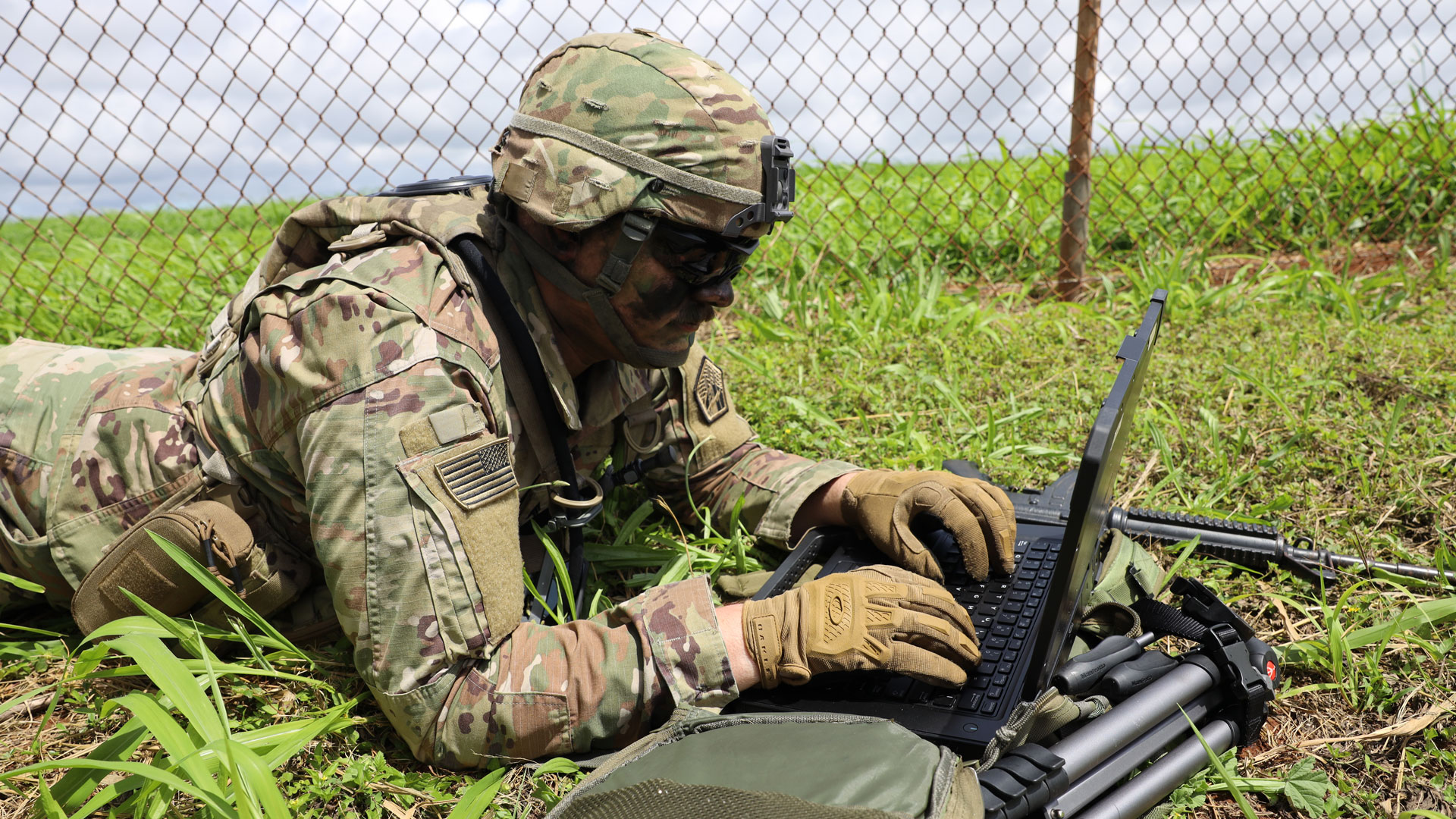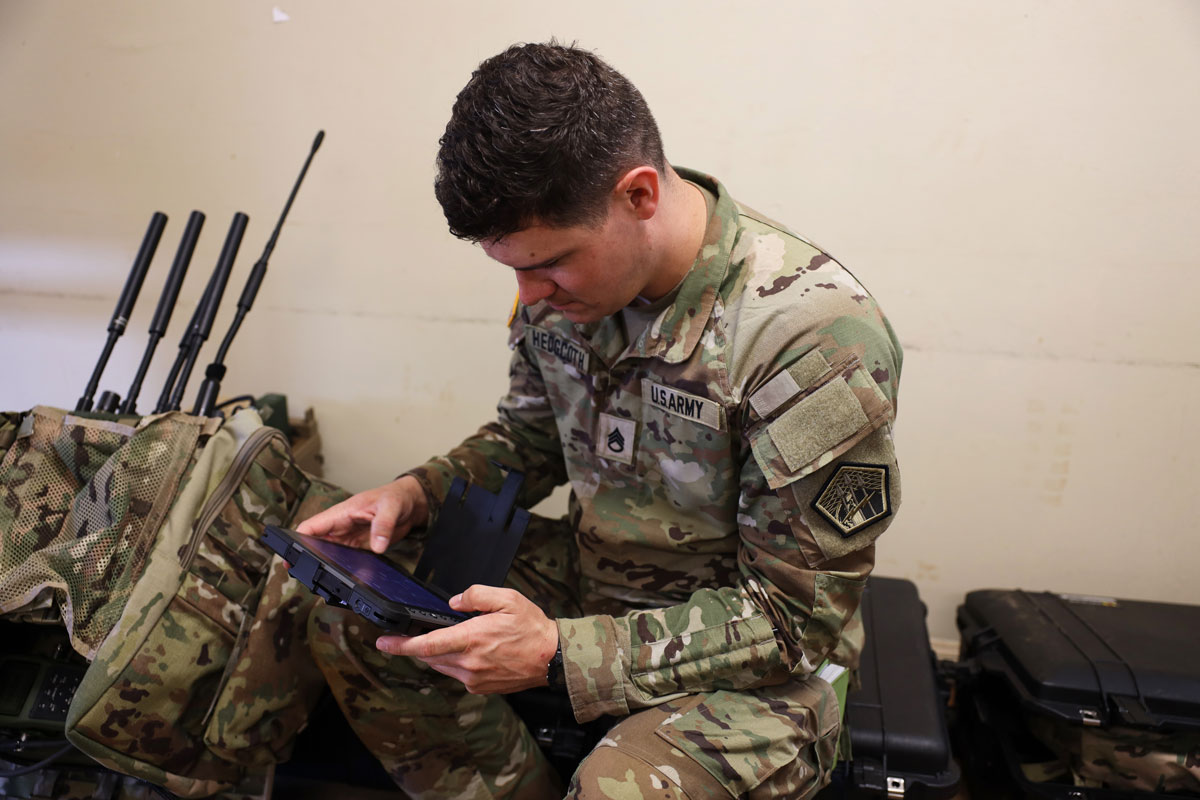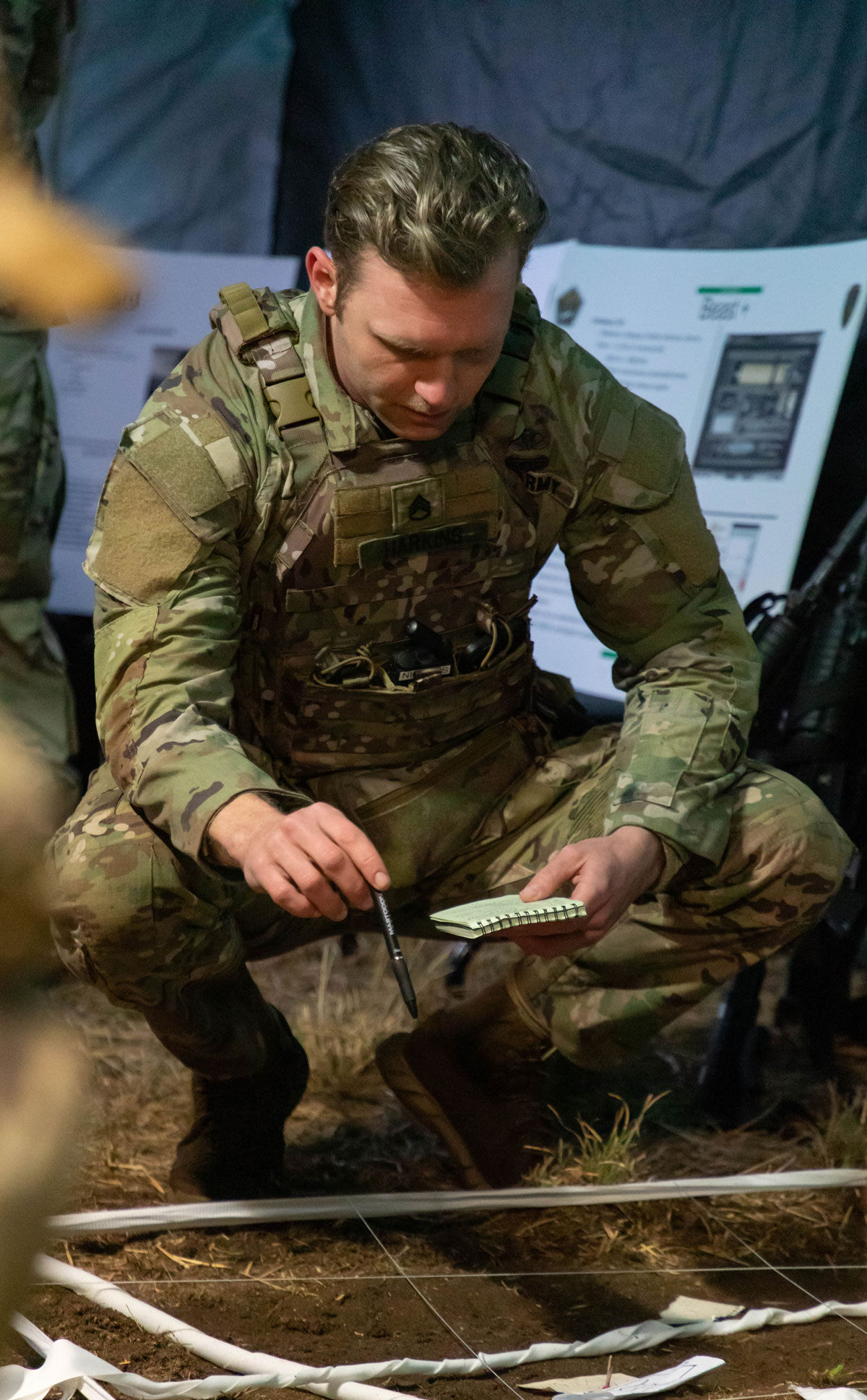Meet 11th Cyber Battalion
Army Cyber's Workhorse for the Triad
By Joshua Good, U.S. Army Cyber Command
Article published on: July 1st 2024, in the Summer/Fall Special Warfare Edition
Read Time: < 6 mins

SCHOFIELD BARRACKS, Hawaii – Sgt. James Hyman, Expeditionary CEMA operator for the 11th Cyber
Battalion’s Expeditionary Cyber-Electromagnetic Activities Team-01, collects information from two sensors –
on an unmanned aerial system and a robotic dog named Spot – to conduct cyber effects operations, during an
Operational Readiness Assessment for the battalion, March 30, 2023.
Photo by Steven Stover, 780th
Military Intelligence Brigade (Cyber)
As Staff Sgt. Chandler Harkins was about to brief his team on the day’s mission, his battalion
commander called the tent to attention.
In walked Lt. Gen. Maria Barrett, commander of U.S. Army Cyber Command (ARCYBER).
“As you were,” Barrett said.
Harkins went right into his briefing, not missing a beat. The electromagnetic warfare specialist walked his team
through the convoy route and pointed out the objective location on a sand table and explained how his team would
collect electromagnetic warfare data at a training range on Fort Eisenhower, Georgia. His Soldiers took notes
and repeated key details, such as the grid coordinates of checkpoints and the objective.
Harkins is a leader in the 11th Cyber Battalion, the workhorse of ARCYBER’s contribution to the new triad—a
combination of space, cyber, and special operations capabilities. After Harkins’ sand table rehearsal, Barrett
spoke with his team members.
“The things you are doing here are super important,” she told them. “We can’t do everything from a computer in
garrison. We are looking to expand access. You are giving commanders options to degrade our adversary’s
capabilities.”
The Soldiers of 11th Cyber Battalion showed Barrett the tools they will use to support the triad, including
drones, a handheld radio spectrum analyzer, and offensive cyber operations equipment.
“Everything can be applied to the triad,” said Lt. Col. Lou Etienne, 11th Cyber Battalion’s commander.
Etienne’s job is to build 12 expeditionary cyberspace electromagnetic activities teams. His marching orders are
to quickly develop cyberspace electromagnetic capabilities and train the expeditionary teams to address the
Army’s multidomain operations capability gaps related to cyber and electromagnetic warfare.

SCHOFIELD BARRACKS, Hawaii – Staff Sgt. Ryan Hedgcoth, Expeditionary Cyber-Electromagnetic
Activities (CEMA) operator with Expeditionary CEMA Team-01, 11th Cyber Battalion, inspects a Tactical RF
Applications Chassis, a platform that enables mission-tailored CEMA capabilities, during an Operational
Readiness Assessment for the battalion, March 29, 2023.
Photo by Steven Stover, 780th Military
Intelligence Brigade (Cyber)
“The focus for preparing for near-peer conflicts is learning how to overcome access denial capabilities of
America’s adversaries,” Etienne said. “We have to understand how to defeat that.”
“Etienne’s team members met with Navy and Marine researchers to learn from their electromagnetic warfare
experience,” said Etienne’s former Executive Officer, Maj. Eric Haupt Jr., who now works as the aide de camp for
Barrett.
“Why reinvent the wheel when someone already has an incredible wheel?” Haupt said.
The 11th Cyber Battalion has cyber, as well as software developers. It has the backing of ARCYBER’s cyber lab,
the Technical Warfare Center, and the Cyber Center of Excellence, the Army school for cyber on Fort Eisenhower,
Georgia.
Former Cyber School Commandant, Brig. Gen. Brian Vile, is an advocate for getting electromagnetic warfare right
and sees 11th Cyber Battalion’s work as aiding maneuver commanders.
“After you break your squelch on your radio, you are going to learn two things eight minutes later,” Vile said at
an Army Maneuver Center’s conference last year. “Number one, how good was your emissions control, your EMCON
(electromagnetic emission control). And, number two, how good are the enemy’s EW (electromagnetic warfare)
Soldiers. Because eight minutes is the doctrinal time it is going to take the adversary’s EW guys to knock out
your grid coordinate, send it back to fires, the king of battle, and have them launch effects on your targets.
And, if your EMCON wasn’t good and the adversary’s EW Soldiers were, you are going to get incoming.”

Staff Sgt. Chandler Harkins is an electromagnetic warfare specialist and leader in the 11th
Cyber Battalion, stationed at Fort Eisenhower, Georgia. Harkins used to work for 7th Special Forces Group
and was a Military Police Soldier before he reclassed to EW.
Photo by Steven Stover, 780th Military
Intelligence Brigade (Cyber)
Advanced military forces use radio frequency triangulation to locate enemy troops and use that information to
engage with indirect fires, such as rockets and artillery.
Etienne and his Soldiers have taken Vile’s eight-minute drill to heart and learn similar lessons as they study
electromagnetic warfare lessons from the war in Ukraine and the Middle East.
“Our enemies are very good at figuring out things to do that are below the threshold of nuclear war that still
have strategic implications,” Etienne said. “Our adversaries are fighting in a gray zone. There is no better
pairing of cyber, space, and special operations forces to be a strategic advantage for the Department of Defense
and for the Army.”
Etienne’s battalion also has the backing of the ARCYBER G39 Information Advantage Division, which is nested under
ARCYBER’s G3, the staff directorate of a general-officer staff section in charge of planning and issuing orders.
Aaron Pearce is the ARCYBER G39 director and in charge of making recommendations about 11th Cyber Battalion’s
future.
“Where we would like to go in the future is to serve as a specialized cyber and electromagnetic warfare force,”
Pearce said.
Pearce sees 11th Cyber Battalion supporting land component units at the theater Army, corps, and division levels.
Most of 11th Cyber Battalion’s missions have been training exercises, such as Combat Training Center rotations at
the National Training Center at Fort Irwin, California, and the Joint Readiness Training Center at Fort Johnson,
Louisiana, formerly Fort Polk.
Those training centers are large enough to support a brigade-plus size unit.
Though an expeditionary cyberspace electromagnetic activities team is a division or higher-level unit asset, the
team could support a brigade if a division commander decided that supported brigade was the main effort.
“That would be up to the corps and division commanders,” Pearce said.
During a recent three-star general officer steering committee meeting, all three commanders said they want to
move from training to operationalizing the Cyber-Space-SOF Triad. “I’m excited for the next 20 years,” said Lt.
Gen. Jonathan Braga, commander of the U.S. Army Special Operations Command. “You will be looking back at this as
the black and white, the dark ages. We are going to help the Army.”
Harkins, 11th Cyber Battalion’s staff sergeant, epitomizes the Soldiers Etienne and his team recruit for the
unit. Harkins was formerly a military police branch Soldier and worked for 7th Special Forces Group before he
reclassed to electromagnetic warfare. Etienne also has Soldiers, who have been coders since middle school.
The battalion is a mix of technical and tactical—just what the Army needs to build the triad.